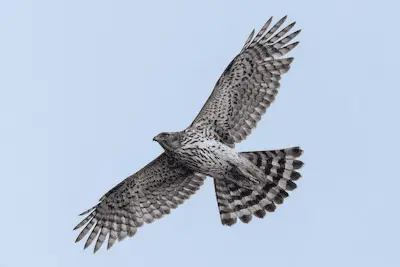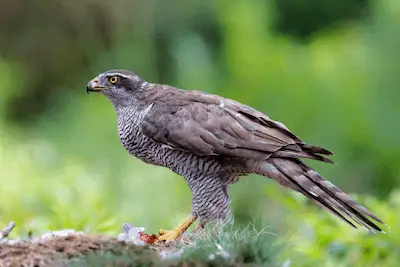Northern Goshawk
(Accipiter gentilis)
The Northern Goshawk is the largest hawk species in Europe, and a fierce hunter that can readily kill prey larger than itself.

Eurasian Goshawks have a broad distribution range stretching from the islands of the Mediterranean to northern Scandinavia, and are only absent from Iceland and Ireland.
In addition to their wide distribution, Northern Goshawks have recently started colonizing large cities in central Europe.
This development is viewed with a lot of excitement by ornithologists, as it follows in the footsteps of the Eurasian Sparrowhawk, which has become a common resident in many European cities.
If Eurasian Goshawks continue to adapt well to living close to humans, this bodes very well for their future prospects.
Eurasian Goshawk facts
The Eurasian Goshawk is a powerful hawk with short broad wings, and extremely strong flight muscles, which is ideal for accelerating very fast in order to overpower its prey with a quick sprint.
In addition to its short wings, the long tail of the Northern Goshawk is ideally suited for fast turns between trees and other vegetation as it pursues its prey.
Northern Goshawk Size
The Eurasian Goshawk is the largest species of hawk in Europe, and approaches the wingspan and weight of a Common Buzzard (though male Northern Goshawks are slightly smaller than this).
- Wingspan: 100-115 cm
- Length: 50-60cm
- Weight: 890-1350 g (females), 590-870 g (males)
The northernmost populations of the Northern Goshawk are larger than their central European counterparts, and large females in northern Scandinavia can weigh up to 2 kg.
The Northern Goshawk is considerably larger and bulkier than its closest relative in Europe, the Eurasian Sparrowhawk (Accipiter nisus).
Appearance
Up close, the Northern Goshawk looks like a fierce raptor with its piercing red eyes and powerful build. When flying or soaring in the air, it’s common to underestimate its size, due to the fact that it flies with extreme precision and elegance.

Sexual dimorphism
Similar to most European raptor species, female Eurasian Goshawks are considerably larger than their male counterparts, to the extent that there is no overlap in size between the two sexes.
Lifespan
A maximum age of 19 years has been documented in the wild, as well as 29 years in captivity.
Scientific name and taxonomy
The scientific name of the Northern Goshawk is Accipiter gentilis. There are 8 known subspecies of the Northern Goshawk, 3 of which occur in Europe. One is found in Corsica and Sardinia, a second one in the northernmost parts of Russia and Scandinavia, while the nominate species is found throughout the rest of Europe.
Eurasian Goshawk distribution
The Eurasian Goshawk has a very wide distribution and can be found almost all over Europe, and is only missing from Iceland and Ireland. Outside of Europe, its range extends eastwards all the way to the Pacific Ocean and Japan, and it also occurs in North America with the subspecies Accipiter gentilis atricapillus.
Northern Goshawk habitat
Northern Goshawks prefer woodland interspersed with open areas, such as clearings, fields, rivers, and hedgerows. For nesting it requires forest with old trees (either coniferous or deciduous), while for hunting the Northern Goshawk prefers variable terrain with open spaces interspersed with trees.
Eurasian Goshawk population size
The European population of the Northern Goshawk is estimated to be between 160,000 to 210,000 breeding pairs by BirdLife International, which makes it the fourth most common raptor in Europe (after the Common Buzzard, Common Kestrel, and Eurasian Sparrowhawk).
The largest part of the European population of Eurasian Goshawks is found in Russia (with up to 110,000 pairs), followed by Germany (up to 13,900 pairs), Sweden (up to 8,000 pairs), and Spain (up to 7,000 pairs).
Northern Goshawk behavior
The most common behavior witnessed from Eurasian Goshawks is flying at low altitude along hedgerows or tree lines, in order to surprise prey that doesn’t have enough time to escape.
Also likes to soar at medium height as it scrutinizes the landscape for suitable prey. Prefers to take its prey close to the ground, which is in contrast to the Peregrine Falcon, which prefers taking birds high up in the air.
Feeding and diet
The Northern Goshawk feeds on a wide variety of prey, and which species are most important depends on the location. As a large and powerful raptor, European Goshawks can take large prey.
This is especially true for females, which are significantly larger than males, and which can kill fully grown hares, as well as large birds, such as geese, herons, and even medium sized raptors, such as buzzards and kites.
However, the most common prey taken by European Goshawks are wood pigeons, jays, thrushes, starlings, and rabbits. As an opportunist, the Northern Goshawk hunts whatever prey species is the most common, or easiest to catch, and this varies considerably by location and by season.
Breeding
The Northern Goshawk builds a large stick nest high in old trees, and reused by the same pair over multiple years. The most common choice of nesting trees are conifers, but deciduous trees also play a large role.
The female lays 2-5 eggs, which are incubated for up to 42 days. After hatching, young Goshawks stay in the nest up to 40 days, and continue to be fed for up to 6 weeks after leaving the nest.
Northern Goshawk Migration
The Northern Goshawk is a partial migrant, with its arctic and subarctic populations being partially migratory, while more southern populations are mostly sedentary.
Similar to the majority of raptor species, juvenile Northern Goshawks move around much more than adults, which often stay close to the breeding territory throughout the year, and defend it against other Northern Goshawks.
Eurasian Goshawk conservation status
Due to its very wide range, and ability to live in cultivated areas, the Northern Goshawk population in Europe is currently stable, and as a result its conservation status is classified as of “Least Concern” by BirdLife International.
There have been decreases in Eurasian Goshawk populations in some areas, but the population has grown in others.
Of particular interest is that some pairs of Eurasian Goshawks have started nesting close to human settlements, suggesting that maybe a similar development to the adaptation of Eurasian Sparrowhawks to breeding in inner cities may be possible for Northern Goshawks.
Threats
The main threat to Northern Goshawks is illegal shooting by hunters, farmers, and pigeon breeders, who all see it as a threat to their own interests. It’s essential to stop this persecution wherever it occurs.
Without persecution by humans, it will be interesting to see if Northern Goshawks will continue to colonize cities, as they have started doing in Berlin and Hamburg in Germany.
Additional resources:
- Levant Sparrowhawk conservation status
- Western Marsh Harrier feeding and diet
- Spanish Imperial Eagle conservation status
